Special needs teacher Katie Smith, was struck down at the age of 30 with debilitating headaches just weeks after returning from her honeymoon. After numerous visits to the GP as well as hospital appointments, her symptoms were finally diagnosed in 2015 as a low-grade oligoastrocytoma brain tumour and Katie was given the agonising prognosis that she may not live to see her 40th birthday. Just over two years later, Katie’s tumour had progressed to grade 3 and was recategorised as an oligodendroglioma.
Katie tells her story...
I met my husband-to-be through an online dating site. We married three years later in 2015 and, as we both worked in education, we were able to take advantage of the long summer break with a six-week honeymoon.
We spent a week in Mexico, stayed with friends in Los Angeles, Las Vegas and with relatives in San Francisco with a final stop in New York before flying home. We treated it as the last adventure we would have for a while since we had both agreed that we would start trying for a family when we returned to the UK.
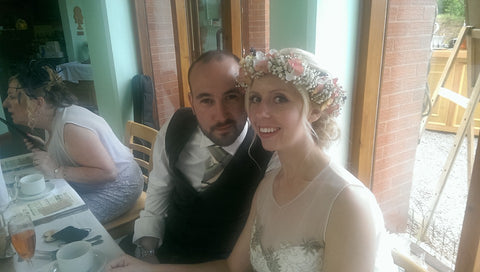
We looked forward to what we hoped would be a long and exciting life together.
It wasn’t long after our return when I started to experience dreadful headaches which became more frequent and increasingly debilitating as the weeks went by. I assumed they were migraines and attributed it to change in my hormones (having recently stopped taking the contraceptive pill) and the stress of a new job.
To start with, I self-medicated and then I saw the GP a number of times. I tried ibuprofen, maximum strength migraine medication, co-codamol, naproxen and amitriptyline. They offered slight relief but never completely alleviated the pain and then the headache would always return.
Even when I slept there was no relief. The pain was so bad it would wake me in the night and it got to the stage where I was frightened to go to bed. Up to this point I had seen several different doctors and each one reassured me that it was nothing serious and I had nothing to worry about. On one trip to A&E I was given diazepam and diclofenac and sent home even though I was still in severe pain. It was only during the last visit to my GP that I finally felt like my symptoms were being taken seriously. Had I seen one doctor consistently then it might have triggered earlier action.
It was all really bad timing in terms of my job. As I was so new in post as Head of English at Wyre Forest in Kidderminster, I didn’t feel I could take time off so I continued going to work each day and struggled through the pain. One time I was physically sick outside the school entrance because the pain was so intense and I was sent home. I think everyone just assumed that I was pregnant and that it was morning sickness!
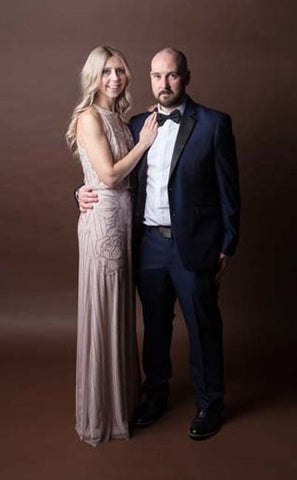
After this incident, I was finally referred for a scan and although it was requested as “urgent” I wasn’t too worried – the doctor had conducted a series of neurological tests and didn’t seem concerned. A brain tumour was the last thing I thought it would be.
Ahead of the hospital appointment, I struggled through my friend’s wedding, making the cake and doing the best I could with my bridesmaid’s duties. The day after the scan I went out for the day with friends.
At 7pm that evening I received a call from my doctor who broke the news that the MRI scan had revealed ‘a lesion’ on my brain and I needed to go to the urgent assessment unit at Russells Hall Hospital immediately.
I could hear the panic in my doctor’s voice. She had stayed behind at the surgery on her son’s first birthday trying to get hold of me – there had been no signal on my mobile for the whole day. The severe headaches were all as a result of the growing pressure on my brain. Had I been left any longer there was a chance I could have died. I will always be grateful to her for what she did that day. I owe her my life.
Once admitted to hospital there were more scans and I was on high doses of dexamethasone to reduce the swelling in my brain. After just two or three days I began to feel better and finally the headaches disappeared. Of course I realised by then that things must be serious. To me, like anyone who hasn’t been diagnosed themselves or doesn’t know someone who has, a brain tumour is synonymous with a death sentence. Despite this, I tried to stay positive. Maybe things wouldn’t be so bad. Maybe they would be able to sort it out quickly. Maybe I would be fine.
I was transferred to Queen Elizabeth Hospital, Birmingham, for emergency surgery and things happened very quickly from there. On the morning of the operation, Luke and I had a bit of a cry together as we considered all the ‘what-ifs’ and potential outcomes. I had avoided looking up brain tumours on the internet but I think Luke had done a fair amount of research by that point. He was fairly positive about the situation and we agreed we would take things one day at a time.
One of the scariest moments was when a member of the surgical team arrived for me to sign the consent form and ran through a list of potential risks. But it was catch 22: sign the form, accepting the possibility of death or life-long impairment or don’t sign the form and just let the brain tumour kill me. I would rather have died than put up with those headaches every day for the rest of my life but the thought of brain surgery absolutely terrified me. Fortunately my parents arrived just in time to see me as I was being taken to theatre. I expect they felt like it might be the last time they would see me alive.

My operation lasted four hours and I was told that they had managed to remove all of the tumour. It had grown to around 6cm, the size of a satsuma. Post-surgery was very surreal. Unbelievably, I felt great and Luke took photos of me, thumbs up and smiling. I was relieved to get home just two days later. I recovered well, in blissful ignorance, oblivious to what lay ahead.
I saw my consultant again in December who told us the basics: that the tumour was a grade two oligoastrocytoma which wouldn’t require any further treatment unless it reoccurred and became more aggressive. I would have another scan in three months time and we would reassess the situation then. We didn’t ask many questions at this stage as we were super relieved that it was low grade. My consultant was sparing with the details. I think he was being kind enough to try to allow us to have a good Christmas.
It was a relief to be told I could stop taking the steroids which had vile side effects. We asked about trying to start a family and we were told we should wait until the next scan and reconsider when we had further information. We left the appointment thinking that everything was going to be okay. That it was all over. But then I started to do my own research, and realised that it was way more serious than we initially thought.
By February the prognosis was clearer: there was a one in three chance the tumour would be back in five years and it would be a higher grade. My chances of living another nine years and making it to 40 were 50/50.
After digesting those words, Luke broke down. We were waiting to collect some new anti-seizure drugs from the hospital pharmacy when I turned around and noticed him slumped up against a wall, crying. It was difficult for me to watch, knowing that I was the cause of all that pain yet was unable to do anything about it. Up to that point he had been so positive but now the reality of the situation was really sinking in.
As I awaited my next scan in July, Luke and I wrestled with making the incredibly hard decision as to whether or not we should try to have a baby.
I felt we needed something to live for but questioned whether I really wanted to bring a child into the world knowing that, potentially, it would lose its mum at a young age. Initially we had agreed that we should try to live our lives the way we would have done had we not known about the tumour. For all we knew it could be years before the tumour returned. In theory this was fine, but the practicalities of having scans and switching over to new drugs that would be less likely to have teratogenic effects (cause foetal abnormalities) was a total nightmare. I was unable to have an MRI scan to monitor the growth of the tumour until I had passed the 12th week of pregnancy and so there was a certain window of time that we had a chance to conceive if I didn’t want to miss a scan. I was also very concerned about whether pregnancy hormones could cause the tumour to grow and, if it came down to it, would I choose myself over my baby?
I had always imagined myself having a big family with at least three children but I realised then that we’d be lucky to have one. It was one of the most difficult decisions I have ever had to make.
Against this background and my planned phased return to work, I was also dealing with my mum’s diagnosis with Non-Hodgkin lymphoma and supporting her as she went through treatment. We spent a lot of time together and decided to write a bucket list of all the things we wanted to achieve, relying on my sister Abbey to complete them if neither Mum nor I were able to. One of those things was to see the Northern Lights and another one was write and publish a book.
It seemed like serendipity when one morning, shortly after we had complied our list, Lorraine Kelly announced her Top Tales competition to find a new children’s author. We all decided to enter but I was the only one that submitted anything to the judges. My Mum was at the hospital arranging her treatment plan when I got a call to say I had made it to the top three from thousands of entries. I ended up winning the competition and was delighted to be able to tick off one of the most difficult items on our list when my book, The Pumpkin Project, was published by Hodder Children’s in October 2016. It felt great to have recognition from a well respected editor that my writing was good enough to be published. It was wonderful to have achieved something like that at such an awful time; to be told that those on the judging panel didn’t know I had a brain tumour, and to be reassured that I didn’t win because of a sympathy vote.
The story is based on my niece Lottie and all royalties from the sale of the book are donated to Brain Tumour Research.
Meanwhile Luke and I finally made a decision to go ahead and try for a baby and I found out I was pregnant in early September 2016
I had always envisaged pregnancy as a joyful time, but our situation made things very different. The initial happiness I felt upon finding out I was pregnant, quickly transformed into fear. Fear, not only that the tumour might progress, but also that I may not get to spend much time with the baby son we were expecting, that I wouldn’t see his key milestones and that he wouldn’t even remember me. I spent most of my pregnancy depressed and anxious about the future.
Eli was born in May 2017 and he was responsible for my change in attitude. I suddenly had a reason to get up every morning instead of sitting in bed wallowing in self pity, waiting to die. Looking back, I feel ashamed that I did that for so long but depression made me selfish and it was difficult for me to find a way back from all my negative thoughts. When Eli arrived, I had something to be enormously grateful for. I had met other women in a similar situation to me who weren’t able to have children and although I’ll never be able to call myself lucky, I felt luckier than a lot of other brain tumour patients. I was still alive with a beautiful baby boy to care for.
I can’t imagine life without Eli. I refer to him as my ‘angel baby’ because he saved me from myself. I honestly don’t think I would be here now if he hadn’t been born. The love I feel for him is beyond anything I have ever experienced and I want him to know when he is older that he gave me a reason to start living again.
It was a huge relief to discover that the first scan following Eli’s birth was stable and we could get on with the difficult, but wonderful task of being first-time parents.
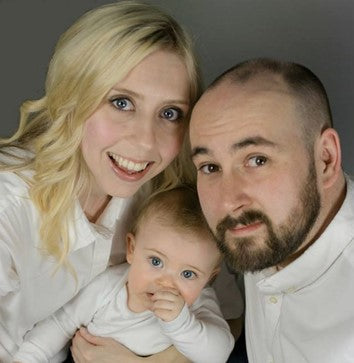
My next scan was due in February 2018, just before we took my Mum on a trip to Iceland to see the Northern Lights. Eli was nine months old and it was his first trip abroad. We received the result upon our return to the UK and it was a massive shock to learn that the tumour had grown fairly significantly and appeared to be more aggressive. I was given the option to watch and wait for another three months to see if there were further changes, but chose to have another craniotomy. My consultant was due to retire the following month and I wanted him to be the person to perform the operation. I begged him to squeeze me onto his list and he agreed. Just six weeks later, which felt like an eternity, I had my second brain surgery which turned out to be on Wear A Hat Day!
I had already been working with the charity Brain Tumour Research, but the news that my tumour was back really strengthened my resolve to raise awareness and funding. We knew that brain tumours were the biggest cancer killer of children and I think having Eli changed my outlook. I asked myself how I would feel if it was my child rather than me who had the tumour. It broke my heart to imagine what I would do in that situation.
The operation went well, but my recovery was much harder the second time round. I really missed Eli, who was now ten months old. We had a joyful reunion in hospital three days later and I just wanted to get home to be with him.
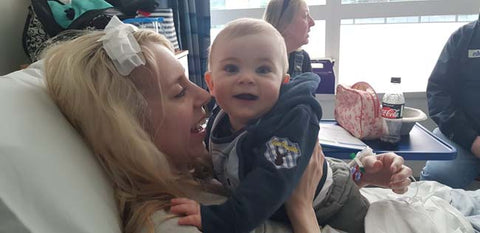
Luke and I had prepared ourselves for the worst news and two weeks later, I learnt that my tumour had progressed to grade three. Of course we were devastated; we thought that we might have another five years before this happened yet, here we were again, just over two years later. But there was also an element of relief that it hadn’t progressed to stage four and new genetic testing revealed a different series of mutations which meant my tumour was recategorised as an oligodendroglioma. I was informed that this type of tumour was more responsive to a certain type of chemotherapy, ultimately giving me a more favourable prognosis.
I began six and a half weeks of radiotherapy on Eli’s first birthday and we had a big party the day before so that we wouldn’t miss celebrating his first special day.
During this time, I relied upon my Dad to drive me to and from New Cross Hospital every day for radiotherapy since I was forced to relinquish my driving licence for medical reasons. I was lucky that my sister was able to provide free childcare while I received my treatment; it made me extremely tired and I struggled to do many of the things I needed to do in order to take care of my one year old.
One of the hardest things about radiotherapy was the fact that I lost all of the hair at the front of my head which I was told would never fully grow back. This massively affected my confidence and there were times that I didn’t want to leave the house. It was very difficult for others to realise how much this affected me. I probably seemed ungrateful and vain to them. But I think that this was down to the misconception that the radiotherapy was going to completely cure me. Had it done so, I would have been very happy to trade my hair for my life. But in reality, permanent hair loss in exchange for an unknown amount of extra time just seemed like another cruel blow.
I think the various misconceptions surrounding brain cancer and brain cancer treatment was something I also found to be a real problem. Even now, I find myself constantly having to justify and explain myself: why I can’t drive anymore; why I have to sleep during the day; why I don’t remember something that someone told me the day before; why I sometimes forget words or struggle to communicate effectively; why I often find it difficult to focus and concentrate; and why I get anxious and stressed when lots of things are happening in a room all at once.
People don’t see anything externally wrong with me so I find it frustrating when I meet someone new, because they don’t know the person I was before all of this happened and make judgements based on the person I have become. I used to have a well-paid, professional job as a secondary school English teacher but I have been forced to give up my career because of everything that has happened and this has had a massive impact on my identity. All of this has been exacerbated by symptoms of early menopause which happened as a result of chemotherapy.
In response to the events of early 2018, I began to write a Blog, and Luke and I decided to set up Brainstorm, a Fundraising Group under the umbrella of Brain Tumour Research. At the beginning of 2019 we began planning a series of events that would help us not only raise money but also awareness of the stark facts and statistics surrounding brain tumours.
By May 2019, we had raised enough money to place three tiles on the Wall of Hope at Brain Tumour Research’s Centre of Excellence at Imperial College in London. These signified the number of days of research our fundraising had already sponsored. Whilst visiting, we toured the labs, discovering first-hand what the money we had raised was being used for and met inspiring neuro-surgeon Kevin O’Neill.
This visit motivated us further and throughout 2019 we organised bucket collections, quiz nights, coffee mornings, car boots, cake sales and concerts. We were lucky that we had so many wonderful friends and family members that supported us in our mission. Our friend Jon ran the London Marathon; my brother-in-law held an old-school DJ night; my friend Naomi organised Samba concerts with her students in local shopping centres and parks; my niece, Lottie, chopped off her hair at a Wear a Hat Day coffee morning arranged by my sister; an old friend did a 100-mile bike ride and actually switched his charity to Brain Tumour Research when he found out about the historic underfunding of brain tumours.
During this time, we were also writing, emailing, tweeting, standing outside stage doors, doing everything we could to get signed hats donated from celebrities that we could auction off at a black tie ball we had planned for the end of the year.
The Brainstorm Ball, held in December 2019, was a huge success. Phillip Serrell from BBC Bargain Hunt conducted our Celebrity Hat Auction which included personally signed hats donated by Lorraine Kelly, Dawn French, Sir Chris Hoy, Noddy Holder, the band Bastille and David de Gea. We even managed to get a Peaky Blinders cap signed by Cillian Murphy which he wore as Tommy Shelby in season three of the show.
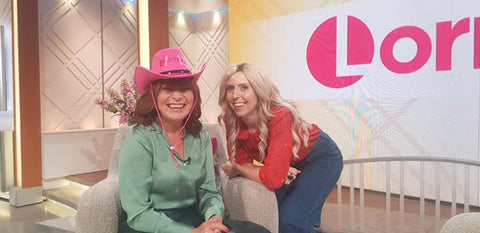
The ball raised £13.5k in just one night and was a wonderful way to round off a year of charity events.
To date we have raised over £56,000 for Brain Tumour Research but unfortunately the covid pandemic has made organising fundraising events virtually impossible. It’s also been incredibly hard for me personally.
Since I finished chemotherapy in 2019 I have been thankful to have had stable scans and really wanted to use the time where there was stability in my health to travel, enjoy new experiences and create special memories with my family. It was very frustrating therefore when the COVID19 pandemic occurred, to be told that I shouldn’t really be going anywhere or doing anything.
It was particularly tough knowing that I have a shorter time-frame than most, but, due to the pandemic, I couldn’t get on with any of the things I wanted to do.
I did however get to experience something incredible in July 2022 when I was proud to be selected as a Queen’s Baton Bearer for the Commonwealth Games after being nominated by Brain Tumour Research.
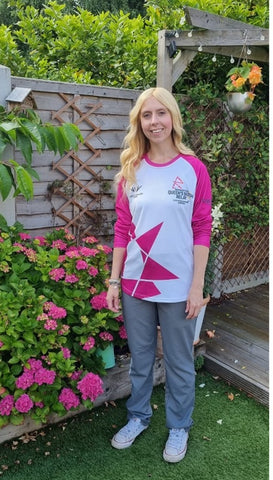
We are now in a position to be able to organise fundraising events again, although the cost of living crisis is still causing a significant impact on how much we can do. We are currently getting ready for Brainstorm’s next event which will be a fancy dress Halloween party in Birmingham.
I have always found fundraising to be a good way of helping me to maintain an element of positively. I want my boy to be proud of his mummy, knowing that I really tried my best to make a difference to families who will find themselves in our situation in the future and to provide some hope to those living with a brain tumour diagnosis.
My goal right now is to reach the age of 40 and to celebrate it in style continuing to tick off things from my bucket list along the way. We are planning to take Eli to Lapland this year to visit Santa Claus and I am very excited to get the chance to make this magical memory with him.
It is such a dire situation to think that brain tumours kill more children and adults under the age of 40 than any other cancer yet just 1% of the national spend on cancer research has been allocated to this devastating disease.
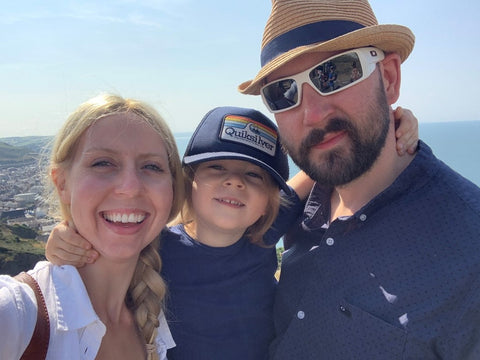
Unless there is some miracle breakthrough on the cards the situation for me remains dire. While I feel we are on an exponential curve with medicine, I am realistic enough to know that discovering treatments for brain tumours is one of the slowest developing areas. The only way we can change this is to put more funding into this area. Raising awareness is the key to this and I will continue to do as much as I can for as long as I am able to do so.
Katie Smith
October 2022
One in three people in the UK knows someone affected by a brain tumour. This disease is indiscriminate; it can affect anyone at any age. What’s more, brain tumours continue to kill more children and adults under the age of 40 than any other cancer yet, to date, just 1% of the national spend on cancer research has been allocated to this devastating disease since records began in 2002.
Brain Tumour Research is determined to change this.
If you have been touched by Katie's story, you may like to make a donation via https://braintumourresearch.org/donate or leave a gift in your will via www.braintumourresearch.org/legacy.
Together we will find a cure.

